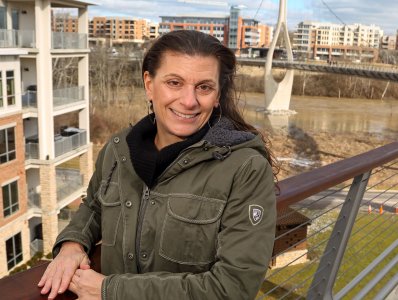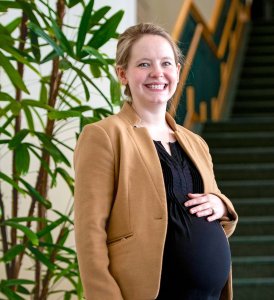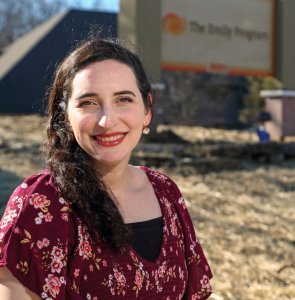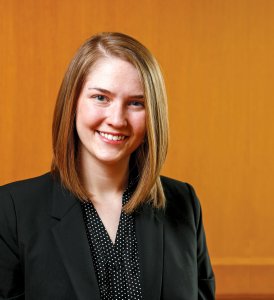A Second Pandemic
Ohio Wesleyan alumni across the country are working at the front lines of a national mental health crisis—providing care for people of all ages and backgrounds. And they have some sage advice for us.
Depression. Anxiety. Addiction. Homelessness.
Ohio Wesleyan University alumni working in mental healthcare are witnessing how the COVID-19 pandemic is amplifying many Americans’ struggles, creating what many see as a second pandemic. This national mental health crisis is stretching thin social support systems that serve as individual coping mechanisms.

“What we’re seeing is a huge crisis brought on by COVID,” says Sue Tafrate ’94, project director for PATH (Projects for Assistance in Transition from Homelessness) and housing and homelessness policy administrator for the Ohio Department of Mental Health and Addiction Services, Columbus.
With specialties ranging from treating those with eating disorders to the LGBTQ+ community to homelessness, with patients ranging from children to veterans to the elderly, OWU alumni now find their life’s work extra challenging during these pandemic times.
Waiting Game
While the COVID-19 virus itself doesn’t directly cause mental illness, pandemic-induced pressures from isolation, lack of child care and caregiving, and income and food instability sent rates of depression soaring from 8.5 percent pre-pandimic in the United States to 32.8 percent in 2021. And the number of people considering suicide is up—again—now at 4.5%. Rates of substance abuse continue to rise, now at 7.7% of adults and 4% of youth, with the CDC estimating 100,000 overdose deaths in 2021 (statistics from Mental Health America).
We’re often seeing clients between 8:00 in the morning and 10 o’clock at night. I’m often here on Sundays and seeing people on the weekends. We’re stretched.

“Prior to the pandemic, there was no shortage of need for mental health services,” says Josh Curie ’08, therapist and clinical director of Josh Curie & Associates Therapy, Ferndale, Michigan. “The pandemic just exacerbated those needs—a lot.”
After two-plus years of COVID-related stressors, finding care is difficult. Providers are overwhelmed with caseloads, pushing many to retire or simply leave the field. With so much demand, clinicians must protect their own mental health.
“Burnout has been huge,” says Curie, who specializes in treating the LGBTQ+ community. ”We’re often seeing clients between 8:00 in the morning and 10 o’clock at night. I’m often here on Sundays and seeing people on the weekends. We’re stretched.”
That means having to be realistic about caseloads. “We have to say, ‘I can’t take just one more person,’ even though the demand is great,” he adds.

The impact is tough on clients, who sometimes spend weeks, sometimes months, hoping to even get on a waitlist.
This bottleneck hits kids especially hard. “We have probably never had enough children’s mental health providers in this country,” says Ellen Sejkora ’13, pediatric psychologist at Children’s Hospital at Dartmouth, in Hanover, New Hampshire, that state’s only pediatric crisis center. “Now, our system is breaking because we have staff shortages. Our staff is getting COVID. Our patients have COVID. It’s just really highlighting the cracks in our system that were already held together with Scotch Tape.”
The waiting game is not just frustrating—it is dangerous.
Lack of coverage can result in those needing the most care to walk away from help.

As time passes before treatment, people become sicker, ultimately needing a higher level of care, says Anna VanMeter ’11, a Columbus-based clinical psychologist who works at The Emily Program, a national organization that helps those with eating disorders. “By the time they get seen by a therapist, they need partial hospitalization or they may need inpatient care,” she adds.
That holds true for young children, too. “Kids are really, truly, genuinely in crisis,” Sejkora says. “We are seeing more suicide attempts; we are seeing more potentially high lethality attempts and more repeated attempts.”
In the homeless community, lengthy waitlists mean some don’t receive care at all. “By the time their appointments come around, those people are nowhere to be found,” Tafrate says.
Protocol Changes
Ironically, the lockdowns and quarantines necessitated by COVID have helped expand treatment options, as telehealth has grown and become an acceptable alternative to in-person appointments. That’s brought help to some who could not have otherwise accessed it.
“People who live two hours from care can now get help easily,” says VanMeter. The Emily Program has offered virtual telehealth services to all but those needing inpatient help since early 2020. “Some people can log on during their lunch hours.”
She says conducting initial evaluations remotely has helped them uncover issues they can address more quickly.
For instance, for those with eating disorders, not only has COVID-19 increased isolation, it has also led to inflation and escalated food insecurity. Telehealth has allowed VanMeter and her colleagues to identify some of those cases early. “That’s changed our treatment— we’re focused on how to get that person enough access to food,” VanMeter adds.
Telehealth has also been vital for families with children fighting cancer. The pandemic adds extra challenges for these children, who are often immunocompromised during chemotherapy.
“Those psychosocial and psychological demands that kids and their families typically face when facing a lifethreatening illness are certainly magnified,” says Brian Delaney ’82, institute psychologist, divisions of psychosocial oncology and palliative care, neuro-oncology, and pediatric cancer genetic risk program at the Dana-Farber Cancer Institute, Boston.
“Telehealth allows us to help families that prefer to meet in a virtual modality at this time,” he says.

At Alvis, telehealth has been a godsend, says Randy Shively ’81, director of research and clinical development, Columbus. The nonprofit human services agency offers reentry support programs, behavioral health and substance abuse treatment services, recovery housing, and services to individuals with developmental disabilities.
“In some correctional facilities, COVID has been spreading rapidly,” he says. “At the start of the pandemic, we knew nothing about telehealth. Our people were trained, and we found it works fairly well one on one.”
However, telehealth causes its own challenges. For those experiencing homelessness, owning a smartphone or tablet can make them a target for robberies, Tafrate says. Economically disadvantaged folks often can’t access a signal strong enough to conduct telehealth via web call.
And in the LGBTQ+ community, home is not always a safe place, making the logistics of telehealth calls difficult.
“People need a safe space to be able to fully open up,” Curie says. “We saw more people taking sessions from their car or outside in a park because maybe they want to talk about a partner or a family member, and maybe what they want to share would set the other person off.”
Prepared for the Unimaginable
While they were undergraduates, none of the OWU alumni could have imagined working in mental health through a global pandemic. Their preparation at OWU, however, moved them down unexplored paths and led them to serve those in need of support in the most difficult times.

“So many professors at OWU helped me to get to where I am,” says Heather Derry-Vick ’10, research faculty at Hackensack Meridian Health Center for Discovery & Innovation, Nutley, New Jersey.
“I really benefited from the expertise of the psychology department. Dr. Dale Swartzentruber was my advisor and provided very helpful guidance on my career path and to take classes that really instilled my excitement about psychology,” she says. “More broadly, OWU’s encouragement of students to explore different disciplines and bring them together in new ways through interdisciplinary work impacted me.”
Delaney also benefited from OWU’s liberal arts approach. He says he learned how to dive into uncharted topics from two professors outside of the hard sciences—writing professor Robert Flanagan and philosophy professor Daniel Anderson.
“What I got from them was an understanding of the importance of exploration, of asking questions and trying to understand. That’s served me well.”
Sejkora double-majored in psychology and neuroscience. “It was a unique experience. I had really remarkable professors, like Jennifer Yates, who was the director of the neuroscience program and taught my intro to psych class,” she says.
“That I did research with Dr. Yates as an undergrad in a liberal arts college is just, like, ridiculous.”
Curie says the diversity and social justice focus of OWU shaped his career trajectory, especially Professor Mary Howard’s work with the homeless community. “She was big on serving people that can’t repay you and doing good work,” he says. “It’s not enough to just talk about it, but to actually get in the trenches and do the work.”
Solutions
With their day-to-day experience on the front lines, the mental health professionals interviewed for this article have wish lists for societal changes and insights that can help us all through difficult times.
To get through the stressors of the pandemic, the alumni agree that society must dig deep to help those in need.
Lack of insurance or adequate insurance often stands in the way of receiving care. According to Mental Health America, more than 10 percent of people with mental illness are uninsured, making it difficult to access expensive care.
“On a national level, we need to eliminate barriers in health care access,” says Derry-Vick, whose work examines how psychosocial factors, such as stressful experiences or depressive symptoms, interact with health conditions—including cancer. “We need to offer continued support and coverage.”
Even for those who have insurance, navigating payment can be tricky. Many health plans do not offer the same depth of coverage for mental health conditions such as addiction or schizophrenia as they do for chronic physical health conditions like diabetes or heart disease.
“Authorization for insurance coverage for higher levels of care can be challenging,” says VanMeter. “Lack of coverage can result in those needing the most care to walk away from help.”
Early in the pandemic, some health insurance companies eliminated deductibles. “Those people didn’t have any out-of-pocket expenses for therapy,” Curie says. “That was really helpful for them to sort through their feelings. However, that ended in July 2021.”
Also, employers can support those who need time off to attend to their mental health, especially for those who need partial hospitalization or inpatient services, the alumni agreed.
Helping Others
In our individual communities and families, knowing how to support loved ones during this time of stress can be difficult.
“Acknowledge their struggles,” Curie says. “And sometimes, simply being able to say, very directly, ‘I care about you’ can go a long way. Let them know you will text and call. Tell them you want to make sure their well-being is being taken care of.”
Be on the lookout for changes in mood, sleeping patterns, and motivation. Know that your loved one may need professional treatment.
“Sometimes loved ones want to be pointed in the right direction, but it is difficult to start. Help them talk with an established health care provider. Use the tools on the Psychology Today website that can filter providers by area and insurance,” Derry-Vick says.
Research shows being altruistic— helping others—makes us feel better. Sometimes family members aren’t available to help, so Currie suggests being neighborly. “Just being observant and knowing what’s going on with your neighbors—if you could pick up a little bit of extra groceries for your elderly neighbor who you know is struggling a little bit—could go a long way in providing support,” he says.
For parents, model a good decision-making process and be transparent about struggles.
“It’s important to be honest with our kids. It’s OK for moms and dads to say ‘we don’t know the answers, but we’re going to talk to a lot of people and make good decisions,’” Sejkora says. “This can become a powerful tool for children to use in their lives.”
Helping Yourself
Strive to be nonjudgmental of your loved ones—and yourself.
“When we or others are under stressful or traumatic conditions, we become more irritable,” Derry-Vick adds. “Some of these conversations could need a break or need a little more patience than they would normally.”
Setting boundaries is key, the alumni say. Give the support you can provide without overwhelming yourself.
“If a friend is trying to text you all day, every day, it’s important to be able to say, ‘I know you need a lot of support, but what I can really give you is maybe a once-a-week phone check,” Curie says. “Help them explore who else they can rely on so that they don’t put that responsibility on only one person.”
Watching media consumption and substance use are important too. From daily reports on COVID to political unrest and war, news provides vital information. However, it can be unsettling. Choose which media you consume and limit your time. And be aware of how much you are drinking or smoking. Is cutting back possible, the experts ask.
Keep moving. “While working from home, it’s easy to become very sedentary. Aim for 15 to 30 minutes of movement every day,” Curie says. Consider taking a walk outside with a friend to add some social time too.
Less Stigma
While getting support for mental health often carries a stigma, the pandemic has forced more people to talk openly about their struggles.
“Mental health has become more of an appropriate thing to talk about, and it’s discussed more openly in the mainstream,” says Nicole Detling ’97, owner of Headstrong Consulting, Salt Lake City. “People are more accepting and open to people’s struggles.”
Individuals feel more comfortable letting others know they are having a hard time. “I have 17-year-old daughters,” says Tafrate. “They and their friends really open up, and I see they have open minds about ending the stigma. I love seeing that for the younger generation.”
With stigma easing, patience and empathy can emerge.
Sejkora says, “If we can just be willing to show a little more kindness, more grace, it can make an impact.”
By Julianne Hill, a freelance writer, producer, and educator based in Chicago.
